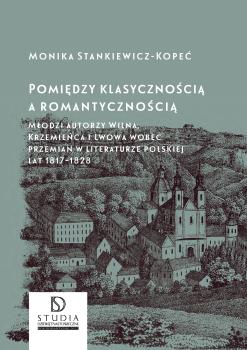Pomiędzy klasycznością a romantycznością : młodzi autorzy Wilna, Krzemieńca i Lwowa wobec przemian w literaturze polskiej lat 1817-1828
Keywords:
literary awareness, early Romanticism, romantic breakthroughSynopsis
The aim of the book is to capture the character of formation and differentiation of literary awareness characterising authors concentrated in four – the most important at that time – literary and cultural environments: in Vilnius (chapter I), Krzemieniec (chapter II), Lviv (chapter III) and Warsaw (chapter IV, summarising), and to conduct the analysis of transitional, boundary manifestations between the Enlightenment and Romanticism as a background for works which are early romantic from the chronological and worldview perspective. This approach allowed to capture the remarkability of early Romanticism and to determine its chronological boundaries in literary process. The centres detailed in the treatise – Vilnius, Krzemieniec, Lviv – constitute perfect subject matter for this purpose since they allow to trace micro-changes taking place within the awareness of authors from these centres in different conditions (social and political, cultural) in the same time range (1817-1828). The subject area discussed in the book provoke reflection on the complexity of the literary and worldview transition from the Enlightenment to Romanticism, and on – what is important – the legitimacy of the unusually popular expression: „romantic breakthrough”. The book also prompts considerations about the forms of currents and their relations. Finally, it inspires reflection on the course of forming of the early romantic worldview.
Chapters
-
TABLE OF CONTENTS
-
WPROWADZENIE .......... 9
-
ROZDZIAŁ I. WILNO .......... 35
-
I. Filomaci wileńscy .......... 35
-
II. Świadomość literacka .......... 52
-
ROZDZIAŁ II. KRZEMIENIEC .......... 115
-
I. Stan badań, formy organizacyjne .......... 115
-
II. Krzemieniec literacki – uwagi ogólne .......... 119
-
III. Przejawy świadomości literackiej .......... 131
-
ROZDZIAŁ III. LWÓW .......... 175
-
I. Towarzystwo Ćwiczącej się Młodzieży w Literaturze Ojczystej w świetle dokumentów Archiwum (1817-1819) .......... 175
-
II. Świadomość literacka autorów lwowskich po 1819 r. ........... 205
-
ROZDZIAŁ IV. ROMANTYCZNY OBRAZ ŚWIATA I JEGO ALTERNATYWY. PODSUMOWANIE .......... 231
-
I. Wszystkie drogi prowadzą do… Warszawy .......... 231
-
III. Ku cezurze 1828 r. .......... 279
-
Nota od redakcji .......... 285
-
Bibliografia .......... 291
-
Indeks osobowy .......... 313
-
Indeks geograficzny .......... 325
References





